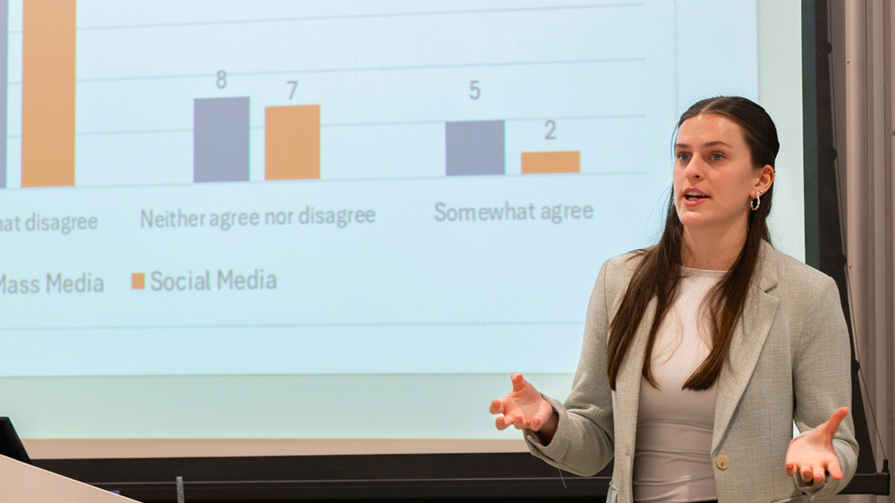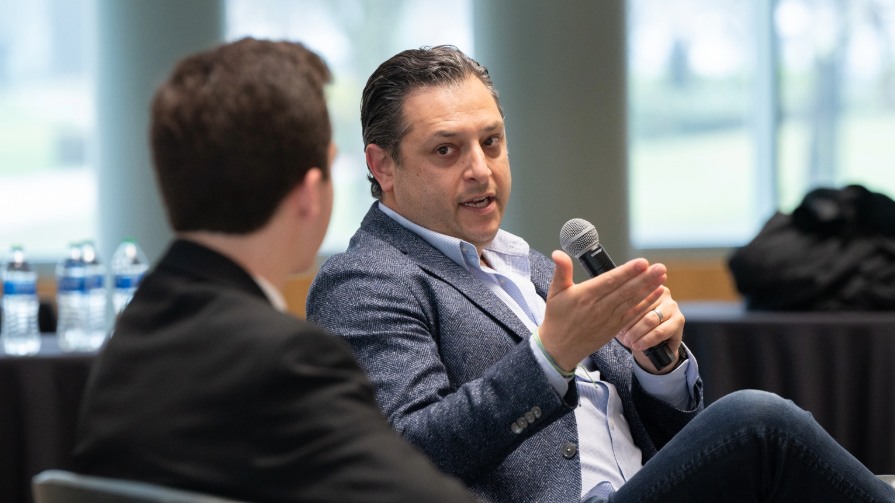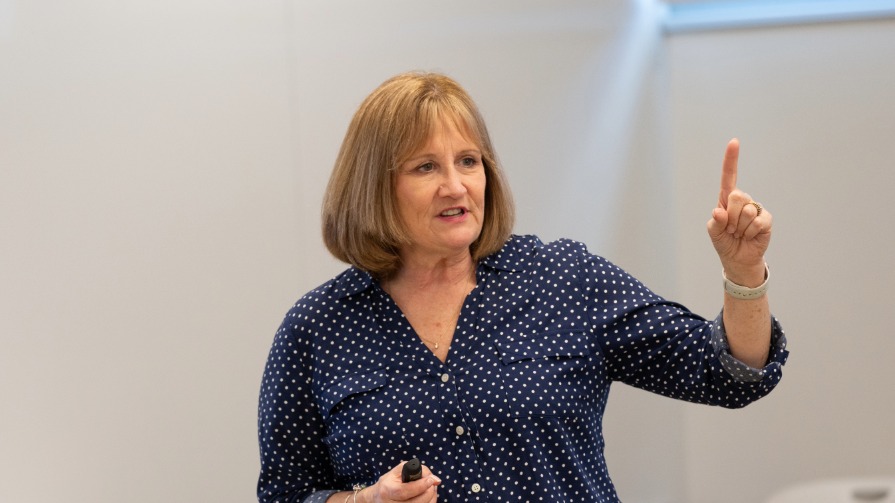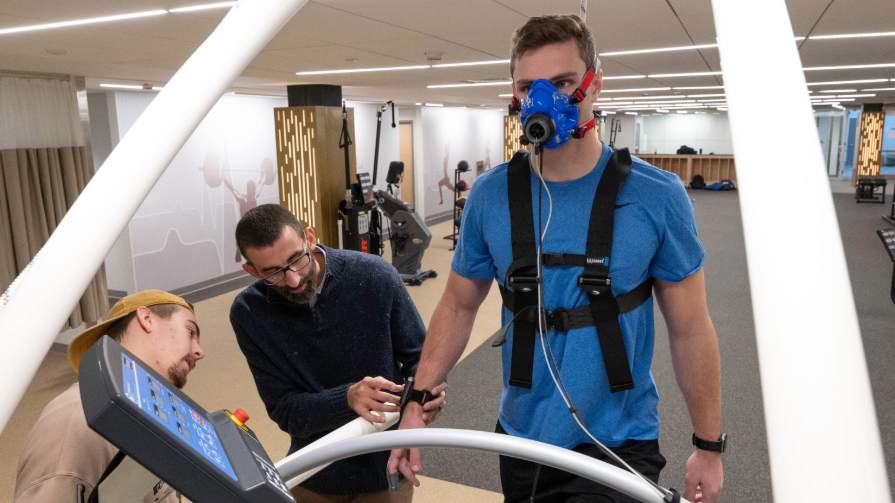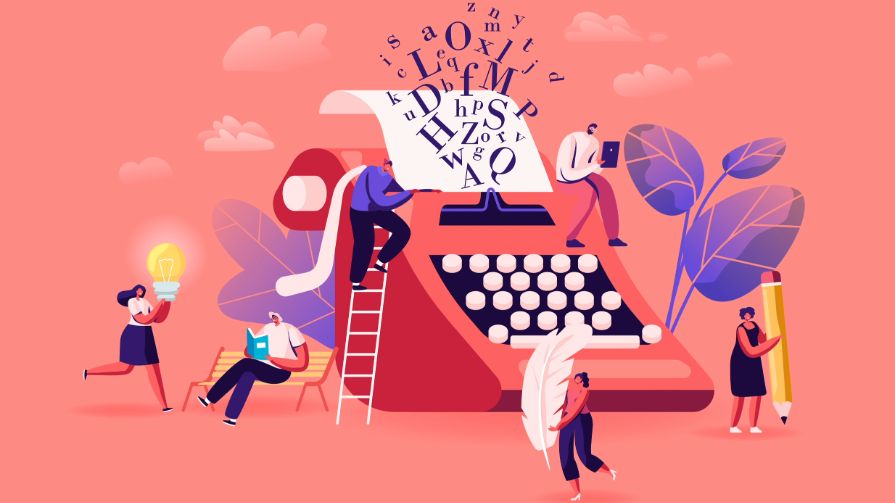Bryant's Innovation and Design Experience for All – IDEA – is a three-day bootcamp for first-year students. This required course shifts their intellectual focus from getting the “right” answer or "earning an A" to developing curiosity, critical thinking, creativity, and problem solving that will serve them in every area of their lives.
Quotable moments, Jan. 23
- “Design thinking definitely opens your mind to many things. ... We feel this is definitely going to help us in the workforce and in internships.” – Cohort 25
- "I'm following #BryantIDEA2019, a 3-day design-thinking workshop required for college freshmen at @BryantUniv. Area businesses pose real problems for each cohort to solve. Great speakers, thinking activities, team-building, and sense of fun. Very impressive!" – Sarah Ducharme (@SDucharme) via Twitter
- "Absolutely one of my favorite campus events...@BryantIDEA. Every Freshman @BryantUniv participates in this 3 day program and today the judges arrive to listen to the students ideas/solutions. #Amazing!" – Greg Pare (@GregPare1) via Twitter
- "Fun following #BryantIDEA2019. Students are learning about Design Thinking while solving problems for local businesses. Truth be told I’ve been looking for my kid in the pics but I was also recently introduced to Design Thinking at work and can’t wait to talk to him about it!" – Lori Pelrine (@lperine22) via Twitter
Trade show, Jan. 23
During the final phase of the design thinking process, students pitched their innovative solutions to more than 100 judges, many of them alumni with years of real-world experience. The trade show was the students’ final opportunity to gather constructive feedback about their idea, and was their moment to shine.
Cohorts had up to 8 minutes to describe their solution, as well as the challenges overcome in each stage of the design thinking process. Judges also asked, poignantly: Is your solution feasible and something the customer wants? Are you comfortable with ideating and innovation?
Members of Cohort 25, who tackled the challenge to find ways that coffee retailers might increase customer satisfaction and experience, agreed they felt prepared. And, as each hour of IDEA passed, "we got more comfortable with receiving feedback. ... We realized you had to be willing to listen, and to keep an open mind."
“Design thinking definitely opens your mind to many things," they added. "We feel this is definitely going to help us in the workforce and in internships.”
Their student mentor, Emma Stewart '19, agreed. “Once students are reminded that the product is not the end goal ... they become much more receptive to feedback.” She added: “The students felt the experience was ‘awesome’…they were genuinely excited” to carry this experience with them into their next four years at Bryant and beyond.
Pitch, brainstorm, and revise, Jan. 23
After working late into Tuesday evening to create storyboards and build a prototype that addressed their design challenge, teams Wednesday morning pitched their prototypes and ideas to their teammates. It was a final opportunity to refine the pitch they would deliver to the Trade Show judges later in the day. They were encouraged to make sure that their final presentations included crucial details that demonstrated how their thinking evolved, and to fine-tune how to describe the insights and real-world observations underpinning their work.
Quotable moments Jan. 22
- “We have a tendency to look at problems in a static way. By looking at the entire journey of a user, you can see where a transformation needs to take place, and get to a solution that delights the user.” – Professor of Management Lori Coakley, Ph.D., Empathy Maps and Journey Maps
- "It’s easy to fall in love with our own idea and tune out when others offer feedback. But listen carefully to feedback. We need it to alter our ideas. […] You’ll have to engage in multiple iterations. Remember: It’s fail often to succeed sooner.” – Professor of Management Michael Roberto, DBA, Storyboarding Workshop
- IDEA “is a life-changing experience. ... We all have habits and rituals – ways of approaching things in the same way. Students come here as freshmen with their habitualized thinking, and this experience counteracts that. It’s a whole new way of thinking and confronting and solving real-world problems in business or society. It reflects Bryant’s approach.” – Terrence Turner, instructor in the Department of History and Social Science
Mentor critique, Jan. 22
During this late-afternoon session, student teams armed with storyboards pitched their design challenge solutions to alumni mentors in order to gain feedback from seasoned professionals. For example, students in one cohort were visited by two alumni – one a mortgage loan processor, another who works at the intersection of tech, financial services, and sales – who noted a flaw in the students' proposal: It had the potential to be at odds with the client's market positioning, business model, or key users.
After receiving feedback, it was back to the drawing board for some teams, then on to prototyping – the construction of 3D models to illustrate the teams' breakthrough ideas.
Storyboarding, Jan. 22
By Tuesday afternoon, students transitioned into the IDEA prototype phase with storyboarding – creating a visual representation of the user's experience as he or she interacting with a new product. A student cohort mentor noted that a storyboard actually is a very early prototype that the students will use to pitch their idea and gain valuable feedback before going through the time and expense of building a physical prototype of their idea.
The storyboard process: Take your group’s most wild, most feasible, and most delightful solutions from your brainstorming session, and storyboard each one. Get feedback. Next, make a fourth storyboard comprised of ideas from the three earlier ones. Get feedback and create an improved solution to pitch to visiting alumni mentors.
Team Dynamics Workshop, Jan. 22
Pingpong balls helped students hone their understanding of iteration and teamwork – skills that are vital to the collaborative, creative problem-solving process that is design thinking.
The workshop featured the Ball Point Game, an exercise that required student teams to devise a system through which they would pass as many pingpong balls as possible; one point per ball. After the first cycle, each team had four additional opportunities to revise the system and run the balls through the cycle and increase the score.
The workshop is timely: Between today’s activities and tomorrow’s finale, cohorts will have iterated their solution to a real-world design challenge many times, including when alumni mentors arrive later this afternoon to provide support and feedback.
Coakley highlighted some takeaways from the exercise that she hope students will carry with them throughout the next phases. She asked the group: “Does working faster improve the process? A little but not really. Generally, it’s not speed, it’s the design of the circle.” She continued, “You’re going to design multiple iterations. You’ll get feedback from alumni mentors today to help you out, which will help you improve so will be best solution possible.”
Quotable moments Jan. 21
- “IDEA is not just an academic exercise. Design thinking is a cutting-edge methodology embraced by a large range of industries and organizations. We love it here at Bryant because it truly lies at the intersection of business and the liberal arts." – Professor of Psychology Allison Butler, Ph.D., IDEA director, Opening Session
- “These could be some of the most important days of your life. The skills you learn in the next 52 hours will ... prepare you for the fourth industrial revolution, which will feature changes to the workforce you can’t comprehend. […] Artificial Intelligence is going to change the world, and you’ve got to be ready. The design thinking skills you learn here today are going to put you in front in the workforce.” – President Ronald K. Machtley, Opening Session
- “Often we’re afraid to share, fearing criticism. In design thinking, we’re not sorry [ …] that’s how we get innovative ideas […] and how we turn traditional problem solving on its head.” – Professor Butler, Opening Session
The Wallet Challenge, Jan. 21
The Wallet Challenge introduces students to the five stages of design thinking – empathize, define, ideate, prototype, test – and the two hallmarks of design thinking: human-centeredness and iteration.
Each cohort's assignment: Use a human-centered approach to make a better wallet.
It begins by empathizing with the user. Students interview a user about what they like or dislike about their wallet. Then, focusing on the user's most compelling need or pain point, the group drafts a problem statement, also known as an insight statement, to guide the design of a prototype. Next, during the ideate phase, the group brainstorms ways to solve the user's problem. That's followed by building a prototype of the "best" idea.
During the “test” phase, the group gives the prototype to the user and watches them interact with it in order to gain feedback and iterate the design further. The cycle continues until the most desirable solution is achieved.
During the challenge, students are prompted to reflect on the extent to which user feedback, rather than designer wishes and goals, affected the design of the prototype.
Introduction to the power of design thinking, Jan. 21
Is design thinking just a classroom teaching tool? Not at all. To illustrate how design thinking – or lack of it – can affect business, Professor Butler offered the students some poignant examples. Up first: The tale of Keurig Cold.
“The Keurig coffee maker. Tell me what you love about it!” she asked.
“Easy! Fast! One cup!” students shouted from the crowd
“Well, on the heels of the success of Keurig coffee makers, Keurig released Keurig Cold,” said Butler. Retailing at $370, the machine could make in one to two hours a single serving of cola, the same beverage one could enjoy with much less time and expense by simply reaching into the fridge and opening a can of Coke.
Keurig Cold was an epic failure because the company “failed to look at the human need this product would address," Butler said. As a result, the product was withdrawn from the market after 10 months, and the company issued a public apology, offered full refunds, and laid off 130 workers.
Butler then shared a videotaped interview with Doug Deets, a lead designer of GE’s Adventure Series MRI machines, designed specifically to allay children’s fears during an MRI exam. Using observation and empathy-based field research, Deets' team identified a child’s anxiety points during the scan. The feedback guided the design of the improved machines and produced better outcomes for children and their families.
The video teed the students up for their next segment of IDEA: observational work in the field.
The how-tos of field research, Jan. 21
Why bother with field observation? Focus groups and surveys are for incremental change, but "observation is used for breakthrough innovation," Professor of Management Michael Roberto, DBA, told the cohorts via a videotaped message.
As part of their IDEA experience, each cohort is challenged challenged to design a solution to one of 35 problems facing a business, community, or organization. An important component for developing a solution is field research conducted at the site of each cohort's project.
Before cohorts left campus for their field research, they took part in a workshop that would guide their observational work.
The workshop exercises helped them learn how to conduct the kind of research that would yield insightful information. Some of the exercises focused on how to circumvent confirmation bias, others explored how to notice adaptations, pain points, and surprising details. A video of an interview gone wrong, featuring Professors Butler and Roberto, offered comedic relief while illustrating the key points of gathering human-centered information.

